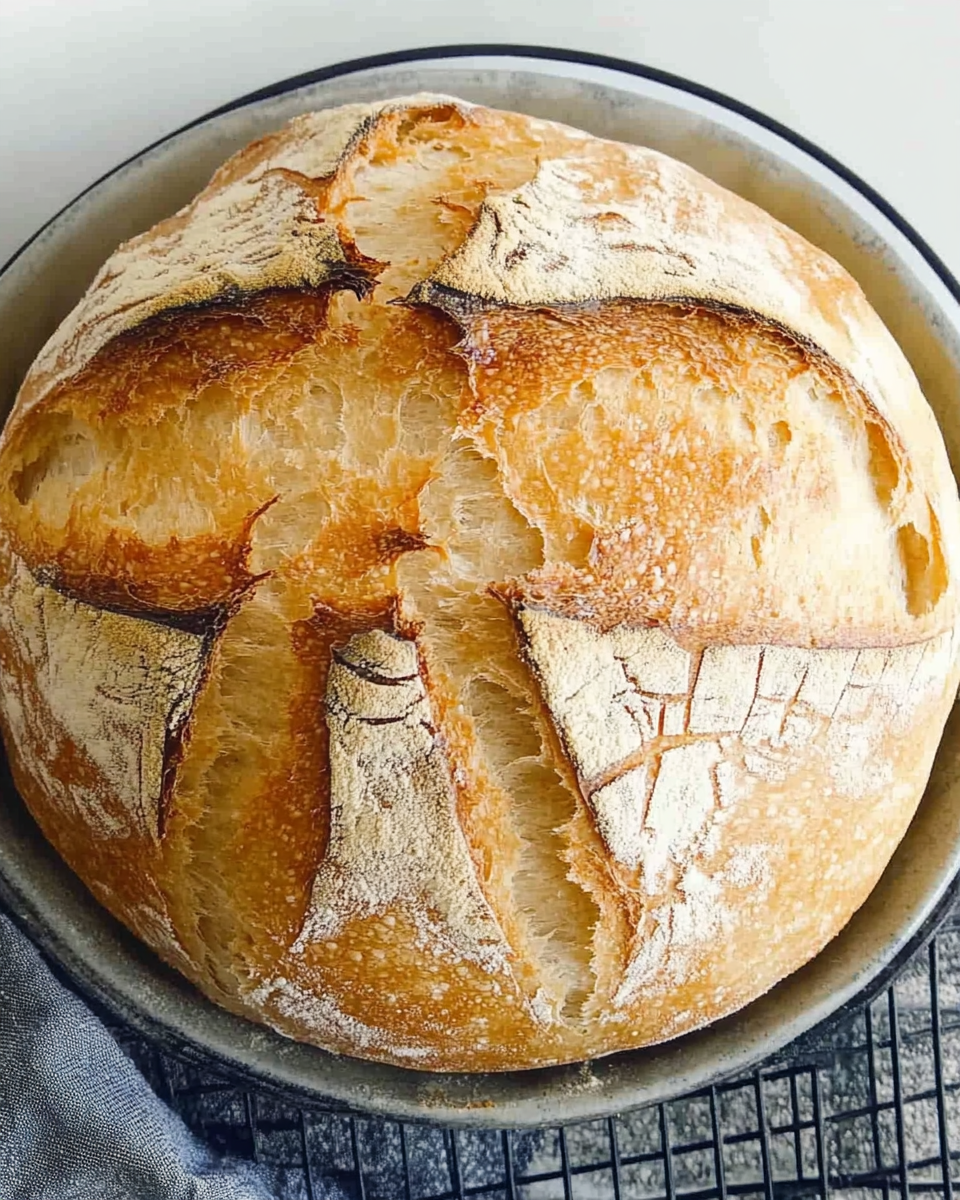Fresh, homemade sourdough bread is often associated with long fermentation times, but this same-day sourdough recipe allows you to enjoy a beautifully crusty loaf with a soft, tangy interior without waiting overnight. Whether you’re new to sourdough baking or just need a quicker method, this recipe delivers excellent flavor and texture in a fraction of the usual time.

Why You’ll Love This Recipe
- No overnight fermentation – Perfect for those who want fresh sourdough in just one day.
- Crusty and flavorful – A crisp, golden crust with a light and airy crumb.
- Beginner-friendly – A great option for new sourdough bakers.
- Minimal hands-on time – While the dough needs to rise, your active time in the kitchen is short.
Ingredients
- 410g all-purpose flour
- 290g water
- 160g active sourdough starter
- 8g salt
Essential Equipment
- Dutch oven – Traps steam to create a crisp, golden crust.
- Bread lame or sharp knife – Used to score the dough before baking.
- Large mixing bowl – Needed for mixing and fermentation.
- Plastic wrap or shower cap – Keeps the dough covered during resting periods.
- Banneton basket or bowl lined with a floured tea towel – Helps the dough maintain its shape during final proofing.
- Parchment paper – Prevents sticking and makes transferring the dough easier.
Step-by-Step Instructions
1. Mix the Ingredients
- In a large mixing bowl, combine the water, sourdough starter, and salt. Stir well to ensure the starter is evenly distributed.
- Add the flour and mix until a rough dough forms. Finish mixing with your hands to ensure all the flour is incorporated.
- Cover the bowl and let the dough rest for 30 minutes.
2. Stretch and Fold
- After resting, perform the first set of stretch and folds:
- Grab one edge of the dough, stretch it upward, and fold it under the opposite side.
- Rotate the bowl 90 degrees and repeat. Complete four folds in total.
- Cover and let the dough rest for 20 minutes.
- Repeat this process four times over the next hour, keeping the dough covered between sets.
3. Bulk Fermentation
- Cover the bowl and let the dough rise at room temperature for 3–4 hours, or until nearly doubled in size.
4. Shape the Dough
- Lightly flour a work surface and gently transfer the dough onto it.
- Fold opposite edges of the dough toward the center and pinch them together.
- Repeat with the other two ends to form a tight, smooth ball.
5. Final Proof
- Line a banneton basket or a bowl with a floured tea towel.
- Place the dough seam-side up into the basket.
- Cover and let the dough rise for 2 hours at room temperature.
6. Preheat the Oven
- During the last hour of proofing, preheat your oven to 460°F (238°C) with the Dutch oven inside.
7. Score and Bake
- Flip the dough onto parchment paper, so the floured bottom is now on top.
- Use a bread lame or sharp knife to score a crisscross pattern on the dough.
- Carefully place the dough (with parchment paper) into the preheated Dutch oven.
- Add a small splash of water between the parchment paper and the Dutch oven to create steam.
- Cover and bake at 460°F (238°C) for 30 minutes.
- Remove the lid and bake for 10 more minutes at 440°F (227°C), or until the crust is deep golden brown.
8. Cooling
- Transfer the bread to a cooling rack.
- Cover with a damp towel and let it cool for at least one hour before slicing.
Tips for Best Results
- Faster proofing: If your kitchen is cool, place the dough in a slightly warm oven (turned off) or near a warm spot to speed up the rise.
- Check proofing readiness: The dough should double in size and pass the poke test—a gentle press should spring back slowly.
- Cutting too soon: Let the bread cool completely before slicing to prevent a gummy texture.
Serving Suggestions
This same-day sourdough bread is versatile and can be enjoyed in many ways. Whether you prefer it plain, toasted, or as an accompaniment to a meal, here are some great ways to serve it:
- With butter and honey – A simple yet delicious way to enjoy fresh sourdough. The butter melts into the warm bread, and the honey adds a touch of sweetness.
- Avocado toast – Spread mashed avocado over a slice and top with salt, pepper, red pepper flakes, or a poached egg.
- Dipped in olive oil and balsamic vinegar – A classic pairing that highlights the bread’s chewy texture and crisp crust.
- As a base for bruschetta – Toast the bread and top it with diced tomatoes, garlic, basil, and olive oil.
- With cheese and charcuterie – Serve slices of sourdough alongside a selection of cheeses, cured meats, nuts, and fruits.
- As a sandwich bread – Use it for hearty sandwiches with fillings like roasted vegetables, grilled chicken, or smoked salmon.
- With soups and stews – This bread is perfect for dipping into hot soups like tomato, butternut squash, or French onion.
- Made into croutons – Cube the bread, toss with olive oil and seasoning, and bake until crispy. Great for salads or soups.
Common Mistakes and How to Avoid Them
Even with a straightforward recipe, a few common mistakes can affect the final result. Here’s how to avoid them:
Using an Inactive Starter
If your sourdough starter is not active and bubbly, the dough will not rise properly. Feed your starter 4 to 6 hours before baking and ensure it has doubled in size before using.
Skipping Stretch and Folds
The stretch and fold technique builds gluten and strengthens the dough. Skipping these steps can lead to a dense and uneven crumb. Make sure to follow the stretch and fold schedule to achieve the best texture.
Under-Proofing or Over-Proofing
- Under-proofed dough will not have enough rise and may result in a dense loaf. If the dough has not doubled in size during bulk fermentation, give it more time.
- Over-proofed dough may collapse and lose its structure. If the dough rises too much, it may become weak and deflate during baking. Keep an eye on the dough, especially during warm weather when proofing happens faster.
Improper Scoring
Scoring helps control how the bread expands in the oven. If you do not score deeply enough, the bread may burst unpredictably. Use a sharp bread lame or knife to make a confident, clean cut.
Baking at the Wrong Temperature
A properly preheated oven is essential. Baking at too low a temperature can result in a pale, undercooked loaf, while an oven that is too hot can burn the crust before the inside is fully baked. Always preheat your oven with the Dutch oven inside for even heat distribution.
Cutting the Bread Too Soon
Slicing the bread while it is still warm can cause the interior to become gummy. Let the loaf cool completely for at least one hour before slicing to allow the crumb to set.
Side Dish Recommendations
Sourdough bread pairs well with many dishes. Here are some great side dish ideas that complement its flavor and texture:
1. Roasted Tomato Soup
A classic pairing, tomato soup and sourdough bread create the perfect comfort meal. The bread can be dipped into the soup or used for a grilled cheese sandwich.
2. Garlic Butter Mushrooms
Sautéed mushrooms with garlic and butter make a flavorful topping for sourdough slices or a great side dish for a rustic meal.
3. Mediterranean Hummus Platter
Serve sourdough with hummus, olives, feta cheese, and fresh vegetables for a Mediterranean-inspired appetizer or light meal.
4. Creamy Butternut Squash Soup
The natural sweetness of butternut squash soup pairs beautifully with the tangy flavor of sourdough. Toasted slices make excellent dipping pieces.
5. Classic Caesar Salad
Homemade sourdough croutons can take a Caesar salad to the next level. Simply cube the bread, toss with olive oil and garlic, and bake until crispy.
6. Beef Stew
A hearty, slow-cooked beef stew is a great pairing for sourdough. The bread soaks up the rich broth, making every bite flavorful.
7. Smoked Salmon and Cream Cheese
Spread cream cheese over sourdough slices and top with smoked salmon, capers, and fresh dill for an elegant brunch dish.
8. Shakshuka
Poached eggs in a spicy tomato and pepper sauce go perfectly with sourdough. The bread is great for scooping up the sauce.
Tips for the Best Same-Day Sourdough
Making sourdough in a single day requires attention to a few key details. These tips will help you achieve the best texture and flavor:
Maintain the Right Dough Temperature
Fermentation happens faster in a warm environment. If your kitchen is cold, place the dough in a slightly warm oven (turned off) or near a warm spot to speed up the rising process.
Use an Active Starter
A sluggish or weak starter will not provide the necessary rise. Ensure your starter is bubbly and doubled in size before mixing it into the dough. If in doubt, perform a float test—drop a spoonful of starter into water. If it floats, it is ready to use.
Be Gentle When Shaping
Rough handling can knock out the air bubbles that create an open crumb. When shaping, fold the dough carefully to maintain structure.
Do Not Skip Preheating the Dutch Oven
A well-preheated Dutch oven helps create steam, which is essential for a crisp crust and proper oven spring. Always preheat it for at least 30–45 minutes before baking.
Allow Proper Cooling
Let the bread cool for at least one hour before slicing. Cutting too soon can result in a gummy texture as steam continues to escape from the loaf.
Storage and Reheating
Proper storage ensures that your bread stays fresh and retains its texture.
Storing at Room Temperature
- Keep the bread in a paper bag or wrapped in a clean kitchen towel for up to two days. This helps maintain the crust while preventing it from drying out too quickly.
- Avoid storing in plastic, as it traps moisture and softens the crust.
Freezing for Long-Term Storage
- If you need to store the bread for a longer period, freeze it. Wrap the whole loaf or individual slices tightly in plastic wrap and aluminum foil before placing it in an airtight bag.
- Sourdough stays fresh in the freezer for up to three months.
Reheating Sourdough Bread
- To refresh a frozen loaf, let it thaw at room temperature for a few hours, then warm it in the oven at 350°F (175°C) for 10–15 minutes.
- For slices, toast them directly from frozen for a quick and crisp result.
Frequently Asked Questions
1. Can I use whole wheat flour instead of all-purpose flour?
Yes, but whole wheat absorbs more water. If substituting, replace up to 50% of the all-purpose flour and add 10–20g extra water to maintain hydration.
2. How do I know when my dough is proofed enough?
The dough should roughly double in size and pass the poke test—gently press the dough with your finger. If the indentation springs back slowly, it is ready to bake.
3. My bread is too dense. What went wrong?
A dense loaf can result from:
- An inactive starter – Make sure it is strong and bubbly before use.
- Under-proofing – The dough may not have had enough time to rise.
- Skipping stretch and folds – These help develop gluten for a better structure.
4. Can I make this recipe without a Dutch oven?
Yes, but you need to create steam another way. Bake the bread on a preheated baking stone or sheet and place a pan of boiling water on the bottom rack to introduce steam.
5. Why is my crust too thick and hard?
A very thick crust can result from:
- Overbaking – Reduce baking time slightly if the crust is too thick.
- Too much flour on the surface – Excess flour can make the crust tough.
- Cooling in a dry environment – Covering the bread with a damp towel while it cools can soften the crust.
6. Can I make this recipe gluten-free?
Sourdough relies on gluten for structure, so a gluten-free version would require different flours and techniques. Look for a specific gluten-free sourdough recipe for best results.
7. How can I get a more open crumb?
For a more open and airy crumb:
- Use higher hydration by adding a little more water.
- Ensure proper stretch and folds to strengthen the dough.
- Avoid over-handling the dough when shaping.
8. What if my bread turns out too sour?
The sourness in sourdough depends on fermentation time. To reduce tanginess:
- Use your starter soon after feeding when it is at peak activity.
- Reduce bulk fermentation time slightly.
- Avoid refrigerating the dough, as cold fermentation increases sourness.
Conclusion
This same-day sourdough recipe is proof that great sourdough bread does not have to take days to make. By following the right techniques, you can achieve a crisp crust, a soft crumb, and a balanced flavor in just a few hours. Whether you enjoy it fresh out of the oven, toasted, or paired with your favorite dishes, this recipe allows you to experience the magic of homemade sourdough without the long wait.
Speedy Same-Day Sourdough Bread
Ingredients
- 410 grams all-purpose flour
- 290 grams water
- 160 grams sourdough starter
- 8 grams salt
- Equipment
- 1 Dutch oven
- 1 bread lame or sharp knife
Instructions
Mix the Ingredients
- In a large bowl, combine water, sourdough starter, and salt. Stir well to evenly disperse the starter and salt.
- Add the flour and mix until combined. Finish mixing with your hands to incorporate all the flour.
- Cover with plastic wrap, foil, or a shower cap, and let the dough rest for 30 minutes.
Stretch and Fold
- After 30 minutes, perform the first set of stretch and folds:
- Grab the edge of the dough, stretch it upward, and fold it under the opposite side.
- Rotate the bowl 90° and repeat, completing 4 folds in total.
- Cover and let rest for 20 minutes.
- Repeat the stretch and fold process four times over the course of 1 hour, covering the dough between sets.
Bulk Fermentation
- Cover the dough and let it rise at room temperature for 3–4 hours, or until nearly doubled in size.
Shape the Dough
- Transfer the dough to a lightly floured surface.
- Shape it by folding opposite ends of the dough and pinching them together at the top. Repeat with the other two ends to form a tight, smooth ball.
Final Proof
- Line a bread or banneton basket with a lightly floured tea towel.
- Place the dough ball into the basket, seam-side up.
- Cover with a plastic bag or cloth and let it rise for 2 hours at room temperature.
Preheat the Oven
- During the final hour of proofing, preheat your oven to 460°F (238°C) with the Dutch oven inside.
Score and Bake
- Transfer the dough to parchment paper, flipping it so the floured bottom becomes the top.
- Score the dough with a bread lame or sharp knife in a crisscross pattern.
- Carefully place the dough (with parchment paper) into the preheated Dutch oven.
- Add a splash of water between the parchment paper and the Dutch oven to create steam.
- Cover with the lid and bake at 460°F (238°C) for 30 minutes.
- Remove the lid and bake for 10 more minutes at 440°F (227°C) for a golden-brown crust.
Cool
- Transfer the bread to a cooling rack. Cover with a damp kitchen towel and let it cool for at least 1 hour before slicing.




Leave a Comment